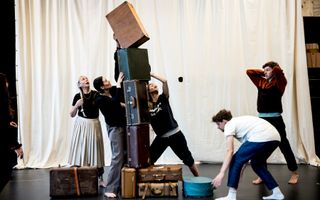 On Stage
On Stage
A useful tool in getting to know and appreciate Shakespeare’s vivid use of words is to use what comes into your mind (your first impression of a word) as fuel to help you imagine a scene or a character.
In the same way pictures and colourful images come to mind as you read a book, Shakespeare used words in the same way, to assist his audience in building the world he attempts to create. Shakespeare plants the seeds and our imagination, as audience, then grows those seeds in our own unique way.
Look closely at the Antipholus of Ephesus monologue, where he pleads to the Duke for help.
Closely examine the words in bold. Write down, next to each word, the first images that come to mind. This can be a stream of consciousness exercise.
By the way we met
My wife, her sister, and a rabble more
Of vile confederates. Along with them
They brought one Pinch, a hungry lean-faced villain,
A mere anatomy, a mountebank,
A threadbare juggler and a fortune-teller,
A needy, hollow-eyed, sharp-looking wretch,
A dead-looking man: this pernicious slave,
Forsooth, took on him as a conjurer,
And, gazing in mine eyes, feeling my pulse,
And with no face, as 'twere, outfacing me,
Cries out, I was possess'd.
Antipholus of Ephesus, Act 5, Scene 1
rabble:
vile confederates:
hungry lean-faced villain:
anatomy:
hollow-eyed:
sharp looking wretch:
dead-looking man:
conjurer:
possessed:
Next, take a moment to question what those images might mean to you. What emotions do they provoke in you? Your response might be very unique to other student responses! You may find certain words have more power than others.
Now that you have begun to create a personal connection to the words (just as an actor on the stage does), say the monologue out loud and allow the images to fill your mind, imagining how those words may also impact upon your audience.







